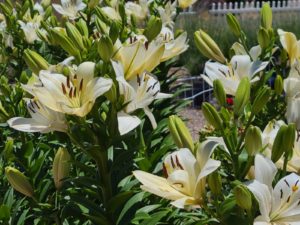August 27, 2014
Backyard Gardener
Why Use Gypsum?
By: Jeff Schalau, Agent, Agriculture & Natural Resources
Gypsum is a popular soil amendment in Arizona. However, there is a lot of misinformation out there about its use and effect on soils. The most commonly, I hear people say “gypsum improves soil structure”. This is true, but only under specific soil conditions. I would contend that many northern Arizona gardeners receive little, if any, benefit by incorporating gypsum to their soil. Let’s learn more about gypsum so we can use it correctly and understand its effect on soil.
Gypsum is the common name for calcium sulfate, a very water-soluble form of calcium. This makes it a good source of plant-available calcium and sulfur. In most soils, calcium is primarily responsible for helping to hold clay particles together in clumps, clods, or “peds” (the term soil scientists use), thus ultimately creating good soil structure. In most Arizona soils, the concentration of calcium in the soil is already high, so an application of gypsum has little or no effect.
Gypsum is most beneficial to soils where excess sodium is present. Some water sources have naturally high levels of sodium and, when used for irrigation, will cause sodium to accumulate. This is especially true when sodium containing irrigation water is not applied deeply and losses to evaporation are high. The first signs of this may be a white crust on the soil surface when it is dry.
Over time, excess sodium causes clay in the soil to become dispersed. When clay disperses, the individual clay particles are no longer held together in aggregates, thus allowing them to fill in spaces preventing water infiltration and percolation. Frequently, this layer of dispersed clay is so dense that the movement of water and oxygen is severely limited. In these situations, applications of gypsum can provide a dramatic improvement in returning the soil to a more permeable condition. The calcium present in gypsum actually displaces the sodium and allows sodium to be leached deeper into the soil when accompanied by deep irrigation.
If your soil drains well, then you probably do not have a sodium problem. Conversely, if you think that you have excess sodium, it is best to confirm this through a soil test. Here, the sodium adsorption ratio (SAR) is used to determine the amount of gypsum needed to mitigate the sodium excess. The publication Using Gypsum and other Calcium Amendments in Southwestern Soils by my colleague Dr. Jim Walworth is linked to the on-line version of this column (see URL below).
Another myth is that gypsum will help reduce soil alkalinity. Sulfur in the form of sulfate will not significantly reduce the pH of the soil. Only elemental sulfur (soil sulfur) or some other acidifying agent will reduce soil alkalinity. Acidification occurs when elemental sulfur and water chemically react to form sulfuric acid. The resulting effect is a slight acidification of the soil near the individual sulfur particles. This is a temporary effect so sulfur can be incorporated on a yearly basis in garden soils, flower beds, and other areas where alkaline soils may impact plant performance.
Agricultural lime is another calcium-containing soil amendment. The primary use of lime in gardening and agriculture is to raise soil pH (to reduce acidity). Unlike gypsum, lime solubility is dependent on soil pH. Its solubility increases in acid soils and decreases as soil pH increases. When soil pH is above approximately 8.2, lime becomes very insoluble. Arizona soils rarely, if ever, benefit from lime applications.
Sometimes gardeners add gypsum to treat blossom end rot: a disease of tomatoes and peppers caused by calcium deficiency. This is usually ineffective as calcium is rarely deficient in Arizona soils. To minimize blossom end rot, avoid water stress by using infrequent, deep irrigation to keep the soil moist and avoid water stress at night. Use mulch to prevent wide fluctuations in soil moisture. Do not over-fertilize plants as higher nitrogen availability can decrease uptake of calcium. Avoid injuring roots during cultivation near plants and do not overwater, especially in heavy clay soils. Blossom end rot is usually an early season problem and becomes less prevalent as the growing season progresses (see the on-line for more information on blossom end rot).
Follow the Backyard Gardener on Twitter – use the link on the BYG website. If you have other gardening questions, call the Master Gardener help line in the Camp Verde office at 928-554-8999 Ext. 3 or e-mail us at verdevalleymg@gmail.com and be sure to include your name, address and phone number. Find past Backyard Gardener columns or provide feedback at the Backyard Gardener web site:http://cals.arizona.edu/yavapai/anr/hort/byg/.
The University of Arizona is an equal opportunity, affirmative action institution. The University does not discriminate on the basis of race, color, religion, national origin, age, disability, veteran status, or sexual orientation in its programs and activities.



No comments.